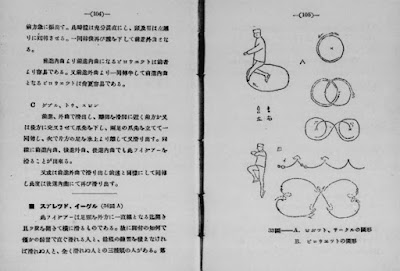Shirō Kawakubo on Lake Yamanaka, near Mount Fuji. Photo courtesy "Skating" magazine.
From 1912 to 1926, Emperor Taishō ruled over the Empire of Japan. During his reign, democracy, modernization and the arts flourished... and thanks the pioneering efforts of a man we know very little about, figure skating gained popularity amongst the Japanese people.
Photo courtesy "Skating" magazine
Shirō Kawakubo hailed from Ikebukuro, in what is today an entertainment and commercial district in Toshima, Tokyo. He took up skating around the start of Emperor Taishō's reign, when he was a high school student, on outdoor ice at the Kanaya Hotel in Nikkō. In a letter penned to Theresa Weld Blanchard in 1933 that appeared in "Skating" magazine, he wrote, "At that time the reckless plain skating is only prevailing and there is no figure skating at all. I have got by chance in 1914 a skating book, 'Handbook of Figure Skating' by the late Mr. Browne, by which I have learnt for the first time 'what is the figure skating,' 'how to learn it.' I was the only Japanese as a figure skating pursuer at that time and have taught it to our younger plain skaters. Since then I have bought quite a lot of skating books, regardless of language (I have now over fifty books) and have studied from simple curve to loop-change-loop, from simple steps to Jackson Haines spins, etc., by myself. Twenty years have elapsed, three indoor rink have established in Japan (one in Tokyo, the other two in Osaka) and the ideal ones (25 by 60 meters) are now under construction in Tokyo. Really skating boom has come in Japan!"
Photo courtesy National Diet Library, Tokyo
Shirō Kawakubo published what were perhaps the first Japanese language books on figure skating in 1912 and 1915. In the decades that followed, he translated over half a dozen figure skating books by George Henry Browne, Herbert Ramon Yglesias, Nikolay Panin-Kolomenkin and Gustave Lussi into Japanese and penned several more of his own books, covering everything from figure skating history to instructional diagrams of school and special figures, jumps and spins, pairs skating, ice dancing and "model programs of well-known skaters". As qualified instructors really didn't exist in Japan during the Taishō period, the first generation of elite figure skaters in Japan would no doubt have been heavily reliant on these texts.
Photo courtesy National Diet Library, Tokyo
In addition to publishing figure skating books, Shirō Kawakubo wore a few other hats. He was a judge at the first Japanese Championships and served as the Secretary of the Japanese Skating Association from 1926 to 1932. He also served a one-year term as the Association's President in 1935, after his contemporary Masamitsu Katano stepped down. For seven years, he taught Prince Kuni Asaakira and his wife Princess Tomoko how to skate.
Photo courtesy National Diet Library, Tokyo
Shirō Kawakubo's passion for figure skating was evident not only his books, but his correspondence to "Skating" magazine in the late twenties and early thirties. He worked tirelessly behind the scenes to promote skating in Japan during the early Shōwa period, when Japan sent its first skaters to the Winter Olympic Games and World Championships.
Very little is known about Shirō Kawakubo's later life, but the fact that he continued to publish new figure skating books in the fifties confirms that he survived World War II. The seeds planted by this pioneering skater paved the way for great Japanese skaters of today like Yuzuru Hanyu, Kaori Sakamoto, Shoma Uno and Riku Miura and Ryuichi Kihara. His views on figure skating can well be summed up by a William Shakespeare quote he chose to use at the beginning of one of his books: "Grace is grace, despite of all controversy."
Skate Guard is a blog dedicated to preserving the rich, colourful and fascinating history of figure skating. Over ten years, the blog has featured over a thousand free articles covering all aspects of the sport's history, as well as four compelling in-depth features. To read the latest articles, follow the blog on Facebook, Twitter, Pinterest and YouTube. If you enjoy Skate Guard, please show your support for this archive by ordering a copy of figure skating reference books "The Almanac of Canadian Figure Skating", "Technical Merit: A History of Figure Skating Jumps" and "A Bibliography of Figure Skating": https://skateguard1.blogspot.com/p/buy-book.html.





